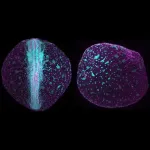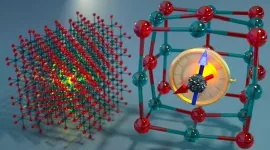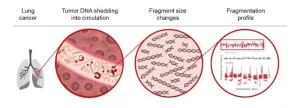(Press-News.org) Around 100 million years ago, a remarkable evolutionary shift allowed placental mammals to diversify and conquer many cold regions of our planet. New research from Stockholm University shows that the typical mammalian heater organ, brown fat, evolved exclusively in modern placental mammals.
In collaboration with the Helmholtz Munich and the Natural History Museum Berlin in Germany, and the University of East Anglia in the U.K., the Stockholm research team demonstrated that marsupials, our distant relatives, possess a not fully evolved form of brown fat. They discovered that the pivotal heat-producing protein called UCP1 became active after the divergence of placental and marsupial mammals. This finding is crucial for understanding the role of brown fat in mammalian evolution, endothermy, and metabolism.
“Our study is an important contribution to understanding the origin and regulation of brown fat,” says Susanne Keipert, co-first author of the study. “The energy-consuming function of brown fat is a major focus of medical research due to its potential to improve obesity, diabetes, and cardiometabolic diseases; all of which have reached pandemic proportions and are among the greatest threats to our healthcare system.”
This work marks the latest milestone from the Jastroch Laboratory at Stockholm University, which has pioneered research on the evolution of mammalian heat production and integrated these evolutionary insights into understanding human metabolic diseases.
The new study “Two-stage evolution of mammalian adipose tissue thermogenesis” published in Science shows:
that the marsupial UCP1 gene is actively transcribed in the adipose tissue of young opossums during a critical developmental period when they first leave their mother and experience cold stress. This is similar to birth of placental mammals, when most babies require brown fat to regulate body temperature.
that during UCP1 transcription, many but not all genes commonly expressed in brown fat are present in marsupials. This indicates that marsupials do not possess the fully evolved brown adipose tissue found in placental mammals.
that the heater protein UCP1 does not produce heat in marsupials, suggesting that this proto-form of brown fat lacks thermogenic function. The function of marsupial UCP1, however, still remains to be discovered.
“This evidence suggests that the gene networks required to enable thermogenesis existed before the divergence of marsupials and placental mammals. However, the pivotal UCP1 protein evolved its ability to produce heat only after the split from marsupials,” explains Martin Jastroch.
Why is it important to study the mammalian family tree to decipher the origin of the brown adipose tissue?
“To find the origin of the brown fat, we cannot use a time machine. However, by examining living species that diverged at different points in evolutionary history, we can determine which have brown adipose tissue and which components of the heat-producing machinery are present. Marsupials have split from placental mammals about 120-180 million years ago. If marsupials had functional brown fat and its thermogenic protein, it would suggest that the organ existed before this split. Since it does not, it likely evolved later,” says Susanne Keipert.
Using bioinformatic tools on UCP1 sequence information from many animals, the researchers reconstructed the ancient UCP1 of the stem placental mammal, as it may have existed about 110 million years ago. They found that this ancient protein could produce heat, indicating the presence of heat-producing brown fat in the ancestor of placental mammals, but not before. This innovation likely enabled placental mammals to thrive in new cold environments.
Find the study “Two-stage evolution of mammalian adipose tissue thermogenesis” published in Science at:
DOI: 10.1126/science.adg1947
FACTS on brown fat:
What does this unique heater organ do?
Brown fat is a unique heater organ in placental mammals, producing heat through a protein called uncoupling protein 1 (UCP1). The UCP1 protein transforms mitochondria, which are the powerhouses of cells, into little heater units which directly convert fat and sugar into heat.
Why is it important that brown fat dissipates energy as heat?
The brown fat enables newborn placental mammals, including human infants, to survive cold stress after leaving the warm womb. It helps maintain body temperature in the cold, as the immature muscle cannot sufficiently shiver. Later in life, the brown fat can protect against metabolic complications by combusting excessive fat and sugars. Understanding how brown fat works is critical for developing therapeutic interventions for metabolic disorders.
END
Marsupials key to discovering the origin of heater organs in mammals
2024-06-06
ELSE PRESS RELEASES FROM THIS DATE:
Epstein-Barr Virus and brain cross-reactivity: possible mechanism for Multiple Sclerosis
2024-06-06
The role that Epstein-Barr Virus (EBV) plays in the development of multiple sclerosis (MS) may be caused a higher level of cross-reactivity, where the body’s immune system binds to the wrong target, than previously thought.
In a new study published in PLOS Pathogens, researchers looked at blood samples from people with multiple sclerosis, as well as healthy people infected with EBV and people recovering from glandular fever caused by recent EBV infection. The study investigated how the immune system deals with EBV infection as part of worldwide efforts to understand how this common virus can lead to the development of multiple ...
Fish out of water: How killifish embryos adapted their development
2024-06-06
The annual killifish lives in regions with extreme drought. A research group at the University of Basel now reports in “Science” that the early embryogenesis of killifish diverges from that of other species. Unlike other fish, their body structure is not predetermined from the outset. This could enable the species to survive dry periods unscathed.
The turquoise killifish inhabits areas characterized by extreme conditions. The species, native to Africa, can survive prolonged periods of drought ...
Novel AI method could improve tissue, tumor analysis and advance treatment of disease
2024-06-06
Researchers at the University of Michigan and Brown University have developed a new computational method to analyze complex tissue data that could transform our current understanding of diseases and how we treat them.
Integrative and Reference-Informed tissue Segmentation, or IRIS, is a novel machine learning and artificial intelligence method that gives biomedical researchers the ability to view more precise information about tissue development, disease pathology and tumor organization.
The findings are published ...
Omega-3 therapy prevents birth-related brain injury in newborn rodents
2024-06-06
NEW YORK, NY--An injectable emulsion containing two omega-3 fatty acids found in fish oil markedly reduced brain damage in newborn rodents after a disruption in the flow of oxygen to the brain near birth, a study by researchers at Columbia University Vagelos College of Physicians and Surgeons has found.
Brain injury due to insufficient oxygen is a severe complication of labor and delivery that occurs in one to three out of every 1,000 live births in the United States. Among babies who survive, the condition can lead to cerebral palsy, cognitive disability, epilepsy, pulmonary hypertension, and neurodevelopmental conditions.
“Hypoxic ...
Calcium oxide’s quantum secret: nearly noiseless qubits
2024-06-06
Calcium oxide is a cheap, chalky chemical compound commonly used in the manufacturing of cement, plaster, paper, and steel. But the material may soon have a more high-tech application.
UChicago Pritzker School of Molecular Engineering researchers and their collaborator in Sweden have used theoretical and computational approaches to discover how tiny, lone atoms of bismuth embedded within solid calcium oxide can act as qubits — the building blocks of quantum computers and quantum communication devices. These qubits are described today in Nature Communications.
“This system has even better properties than we expected,” said Giulia Galli, Liew Family Professor ...
Innovative combination therapy shows promise for bladder cancer patients unresponsive to standard treatment
2024-06-06
TAMPA, Fla. (June 6, 2024) — In a groundbreaking advance that could revolutionize bladder cancer treatment, a novel combination of cretostimogene grenadenorepvec and pembrolizumab has shown remarkable efficacy in patients with Bacillus Calmette-Guérin (BCG)-unresponsive non-muscle invasive bladder cancer. Results from the phase 2 CORE-001 trial, published today in Nature Medicine, reveal a significant improvement in complete response rates and long-term disease control, offering new hope for patients with this challenging condition who face limited treatment options.
The trial included patients with BCG-unresponsive carcinoma in situ of the bladder, a condition that is notoriously ...
SFU Physics collaboration pushes an information engine to its limits
2024-06-06
The molecules that make up the matter around us are in constant motion. What if we could harness that energy and put it to use?
Over 150 years ago Maxwell theorized that if molecules’ motion could be measured accurately, this information could be used to power an engine. Until recently this was a thought experiment, but technological breakthroughs have made it possible to build working information engines in the lab.
With funding from the Foundational Questions Institute, SFU Physics professors John Bechhoefer and David Sivak teamed up to build an information engine and test its limits. Their work has greatly advanced ...
Artificial intelligence blood test provides a reliable way to identify lung cancer
2024-06-06
Using artificial intelligence technology to identify patterns of DNA fragments associated with lung cancer, researchers from the Johns Hopkins Kimmel Cancer Center and other institutions have developed and validated a liquid biopsy that may help identify lung cancer earlier.
In a prospective study published June 3 in Cancer Discovery, the team demonstrated that artificial intelligence technology could identify people more likely to have lung cancer based on DNA fragment patterns in the blood. The study enrolled about 1,000 participants with and without cancer who met the criteria for traditional lung ...
The ethical matrix: it's not just smart; it's the smart thing to do
2024-06-06
Artificial Intelligence (AI) is the talk of the town, but far too often expediency has been the driver, not responsible innovation. The NYC Media Lab (NYCML) at NYU Tandon School of Engineering and Bertelsmann launched their 4th challenge this month, this time aimed at mentoring teams with projects that use AI to responsibly advance their fields.
The 2024 collaboration, The Ethical Matrix Challenge: Forging New AI Frontiers in Media, Communications, Education, and Healthcare, focuses on ethical AI and its power to have a real-world influence. The four selected teams have projects that can responsibly revolutionize the way ...
Study: Young athletes at risk for elevated blood pressure rates, future cardiovascular complications
2024-06-06
A substantial portion of young athletes are at risk of hypertension, according to a study presented at the American College of Cardiology’s Care of the Athletic Heart conference, taking place on June 6-8 in Washington.
High blood pressure, also known as hypertension, occurs in 47% of adults in the U.S., according to CardioSmart.org. Over time, hypertension weakens the heart, blood vessels and kidneys, paving the way for potential stroke or heart attack. Often referred to as the “silent killer,” high blood pressure is a leading risk factor for heart disease and early death.
The 2017 ACC/American Heart Association Guideline for the Prevention, ...




